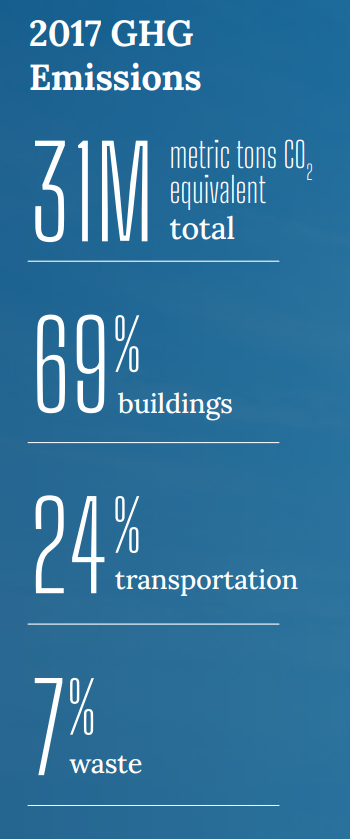Electrify Chicago
An independent tool for viewing City of Chicago building data
According to the
2022 Chicago Climate Action Plan,
69% of Chicago's emissions come from buildings, making
building emissions our biggest challenge and our biggest opportunity as a city
to tackle climate change. At Electrify Chicago, we showcase building performance using
publicly available data supplemented by community-submitted photographs and building
owners.
Start by looking at Chicago's buildings with the highest greenhouse gas intensity i.e. emissions per square foot. Large, efficient, buildings can perform much better than very inefficient small buildings on this metric.
New Article
📰 $30 Million In Missed Fines
The City Of Chicago failed to collect $30 million in potential fines from the building benchmarking ordinance, reducing transparency and accountability.
Legislative update! 🎉
As of late January 2024, legislation is being introduced to require new use more efficient forms of water and space heating, via the Clean And Affordable Buildings Ordinance (CABO), which will reduce the number of highly polluting and inefficient buildings that end up on this site.
If you're in Chicago,
write to your alderman to support the CABO!
Chicago Buildings by Greenhouse Gas Intensity
Note: Data only includes large Chicago buildings from 2021, unless explicitly stated otherwise.
Note: This data only includes buildings whose emissions are reported
under the
Chicago Energy Benchmarking Ordinance. According to the City “As of 2016,
this list includes all commercial, institutional, and residential buildings larger than
50,000 square feet.” This dataset is also then filtered to only buildings with
reported emissions > 1,000 metric tons CO2 equivalent.
This data is also from 2021, but when new benchmark data is available, we'll update the site.
| Property Name / address | Primary Property Type |
Greenhouse Gas Intensity (kg CO2 eq./sqft) |
Total Greenhouse Emissions (metric tons CO2 eq.) |
|---|---|---|---|
|
1950 - SOUTH LOOP
1300 S Clinton St
| Retail Store | 12.0 kg/sqft
Highest 10%
| 1,281 tons
Highest 37%
|
|
840 North Michigan Avenue Acquisition LLC
840 N Michigan Ave
| Retail Store | 12.0 kg/sqft
Highest 10%
| 1,043 tons
Highest 44%
|
|
University High School
5840 S Kenwood Ave
| K-12 School | 12.0 kg/sqft
Highest 10%
| 1,089 tons
Highest 42%
|
|
North+Vine
633 W NORTH AVE
| Multifamily Housing | 11.9 kg/sqft
Highest 10%
| 2,984 tons
Highest 14%
|
|
1976 - LINCOLN PARK
2647 2679 N Halsted St
| Retail Store | 11.9 kg/sqft
Highest 10%
| 949 tons
Highest 47%
|
|
311 W. Superior
311 W Superior St
| Office | 11.8 kg/sqft
Highest 10%
| 1,081 tons
Highest 42%
|
|
207
4640 S Halsted St
| Supermarket/Grocery Store | 11.8 kg/sqft
Highest 10%
| 1,730 tons
Highest 27%
|
|
919 S California Ave.
919 S California Ave
| Other | 11.8 kg/sqft
Highest 10%
| 1,001 tons
Highest 45%
|
|
Harper Court
5235 S Harper Ct
| Office | 11.8 kg/sqft
Highest 10%
| 2,729 tons
Highest 15%
|
|
The Garland Building Office Condominium
111 N Wabash Ave
| Office | 11.8 kg/sqft
Highest 10%
| 3,062 tons
Highest 13%
|
|
Incubator Building
(Illinois Tech)
55 W 34th Street
| College/University | 11.7 kg/sqft
Highest 11%
| 846 tons
Lowest 49%
|
|
Walmart Supercenter #5617
4626 W Diversey Ave
| Wholesale Club/Supercenter | 11.7 kg/sqft
Highest 11%
| 1,360 tons
Highest 34%
|
|
Francis W Parker School
330 W Webster Ave
| K-12 School | 11.7 kg/sqft
Highest 11%
| 2,721 tons
Highest 15%
|
|
Park Michigan
1212 S Michigan Ave
| Multifamily Housing | 11.7 kg/sqft
Highest 11%
| 2,784 tons
Highest 15%
|
|
HAROLD WASHINGTON LIBRARY
(Chicago)
400 S State St
| Library | 11.7 kg/sqft
Highest 11%
| 8,853 tons
Highest 3%
|
Data Source:
Chicago Energy Benchmarking Data
